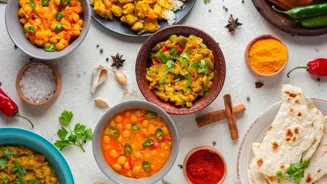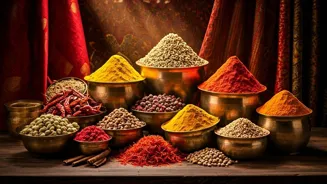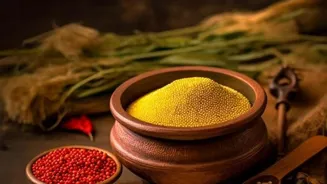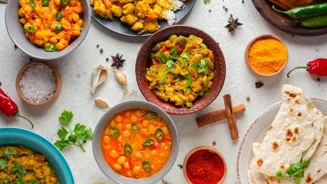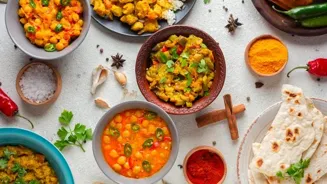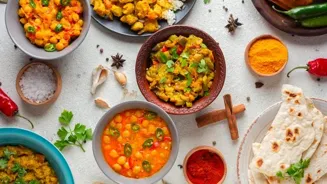Dive into the global impact of Indian cuisine - a flavorful journey shaping culinary trends worldwide!
The aroma of spices, the vibrant colours, and the sheer variety – Indian cuisine has long been a favourite,
not just in India, but across the globe. But its influence goes beyond just satisfying taste buds.
It's subtly, yet powerfully, shaping global food trends, influencing how chefs cook, what ingredients are used, and what diners expect.
From the humble "turmeric latte" to the complex flavours of a perfectly balanced vegetarian thali, Indian culinary traditions are leaving an indelible mark on the international stage.
Let's take a deep dive into this fascinating story of flavour and influence, exploring how Indian food is making its presence felt in kitchens and restaurants worldwide.
Indian cuisine's influence on global vegetarian trends
One major aspect of Indian cuisine's influence is the increased appreciation for vegetarian and vegan options. For centuries, vegetarianism has been a way of life for many in India. This rich tradition has resulted in a diverse and innovative range of vegetarian dishes.
As the world becomes more conscious about health and sustainability, vegetarian and vegan diets are gaining traction. Indian food, with its naturally plant-based approach to many dishes, offers a delicious and readily available solution.
Dishes like vegetable biryani, dal makhani (without butter, for a vegan version), and chana masala are finding their way onto global menus, showcasing the versatility and flavour potential of vegetarian cooking.
This has encouraged chefs worldwide to experiment with plant-based ingredients and create their unique vegetarian offerings, often drawing inspiration from Indian techniques and flavour combinations. The global food scene is seeing more and more meat-free restaurants that offer flavorful dishes.
Indian spices lead global cuisine with health benefits and rich flavors, boosting demand
The growing popularity of spices is another key area where Indian cuisine is leading the way. For centuries, India has been known as the "Land of Spices," and this reputation continues to influence global palates.
Turmeric, cumin, coriander, cardamom, and ginger are just a few examples of spices that are now widely used in cuisines around the world. The health benefits associated with these spices, especially turmeric with its anti-inflammatory properties, have further fueled their popularity.
Moreover, the complex flavour profiles that Indian spices add to dishes are highly valued. Chefs are using spice blends like garam masala to elevate the taste of their creations, while home cooks are experimenting with individual spices to recreate their favourite Indian-inspired meals.
This has led to an increased demand for high-quality spices from India, supporting local farmers and preserving traditional spice-growing practices. The popularity of spice mixes is growing as it allows for ease of adding flavor in any dish.
Thali: a diverse, balanced Indian meal gaining global popularity in restaurants
The concept of "thali," a complete meal served on a single platter with a variety of dishes, is also gaining recognition globally. Thali is an excellent way to experience the diversity of Indian cuisine in one sitting.
It typically includes a mix of curries, vegetables, dals, rice, roti, and accompaniments like pickles and chutneys. The thali presents a balanced and satisfying meal, and it also provides a cultural experience.
Restaurants around the world are adopting the thali concept, offering their own versions with local ingredients and flavours. This adaptation not only introduces diners to a wider range of tastes and textures but also encourages a more mindful and balanced approach to eating.
Diners are able to get a balanced and healthy food thali.
Indian cooking techniques gaining global popularity for flavor infusion
Indian cooking techniques are being embraced by chefs globally. Slow cooking, a traditional method in Indian cuisine, is becoming increasingly popular for its ability to draw out flavours and create tender dishes.
The dum pukht method, where food is cooked in a sealed container over low heat, is particularly admired for its ability to infuse ingredients with maximum flavour.
Tempering spices in oil (tadka) to release their aroma and flavour before adding them to a dish is another technique that is gaining traction. These methods are now being incorporated into various cuisines, adding depth and complexity to dishes.
Chefs are also using traditional Indian cooking equipment like tandoors (clay ovens) to create authentic flavours and textures. The use of these traditional skills and flavors that increase the taste of dishes is appreciated.
Indian flavors fused with global cuisines create innovative culinary experiences
The fusion of Indian flavours with global cuisines is also a significant trend. Chefs are creatively blending Indian spices and ingredients with Western, Asian, and Latin American dishes to create unique and exciting culinary experiences.

For example, you might find a samosa spiced with Mexican flavours or a dosa filled with Italian-inspired ingredients. This fusion approach allows chefs to experiment and push the boundaries of traditional cooking, while also introducing diners to new and unexpected flavour combinations.
The result is a vibrant and diverse culinary landscape that reflects the interconnectedness of global cultures, creating Indian and global food hybridity.
Indian cuisine's global impact and future trends
Ultimately, the influence of Indian cuisine on global food trends is a testament to its rich history, diverse flavours, and adaptability.

As the world becomes increasingly interconnected, we can expect to see even more creative collaborations and innovations that celebrate the beauty and versatility of Indian food.
The story of Indian cuisine's global sway is just beginning, and it promises to be a delicious journey filled with exciting flavours and cultural exchange. The spread of the love of food across the globe will continue.
AI Generated Content. Glance/InMobi shall have no liability for the content